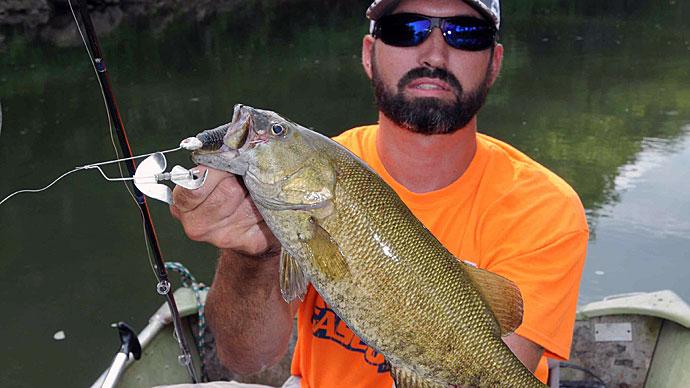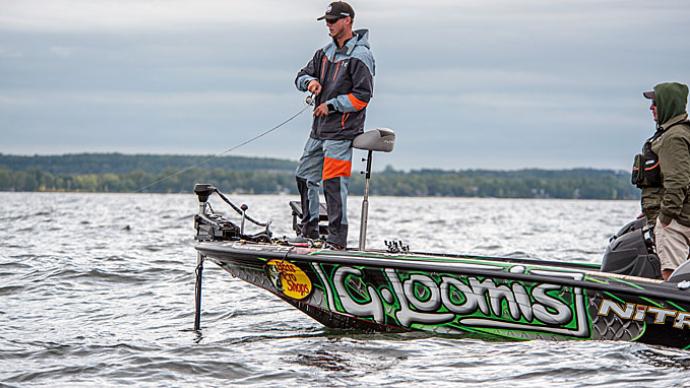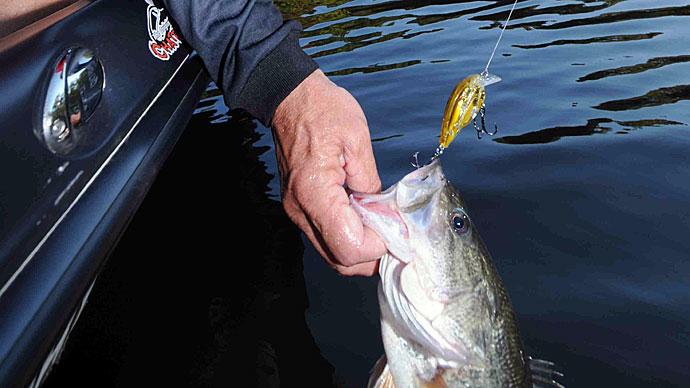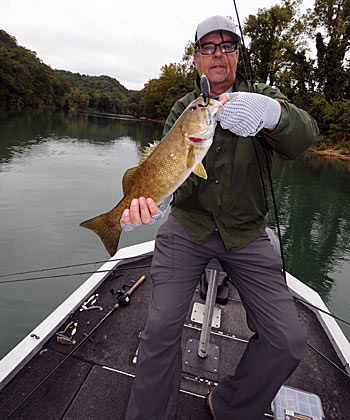
The smallmouth were right where he said they would be.
During a Missouri Outdoor Communicators outing at Southern Comfort Cabins and RV Campground in Doniphan, Mo., I got to fish with Bill Smith of Scenic Rivers Guide Service on the Current River. While talking to Smith before we launched his jet-drive boat, Smith explained the fall smallmouth pattern that was starting on the river. “The bass sometimes will still be in faster water—maybe not as much in the head of the fast chutes—they may be pulled back from there.”
When fall arrives, smallmouth bass on Smith’s home waters start to migrate from the head of the faster water towards the lower section of the swift water en route to their winter holes. “They will start moving and transition in pockets or some of the holes getting ready for the wintertime,” Smith said. While prefishing the day before our trip, Smith caught smallmouth holding in the middle and lower sections of the fast water, which is where we keyed on the next day and a half.
Smith starts keying on the fast water sections of a river in late summer, and by early fall, he can still catch smallmouth around logs 1 to 3 feet deep, but the following week the fish could be holding deeper in the channel along the rocks. The river guide tries a variety of lures in the fall because of the fish transitioning from shallow to deep water and different types of cover.
River smallmouth in the fall will move to the shallow gravel banks to feed on minnows in the early morning. So Smith will tempt these fish with spinnerbaits, Jewel Bait Company Gem Blades 2.0 rigged with swimbaits, Flukes, and topwater lures. Later in the day, the fish tend to pull back rocks in deeper water, where Smith throws Ned Rigs with Z-Man Finesse TRD worms, 4-inch Senkos or jigs, and plastic craws.
“I will have six to eight rods fixed up because, in one area, you can fish a certain bait better in that type of structure, or you get into an area with a little faster water that has a lot of logs in it, and you want to get in over that stuff,” Smith says. “So that is where you want to throw a spinnerbait or swimbait—something you can keep up because of the cover.” Smith runs the spinnerbait or swimbait over the logs and lets the lure flutter down with the current once it passes over the cover.
When he finds smallmouth staging in the open channel, Smith favors throwing bottom-bouncing lures such as a tube bait or plastic worm. By late fall, Smith switches to a 1/4-ounce homemade bucktail jig in crawfish colors for probing the deeper holes smallmouth move into for the winter. The river is usually gin clear during this time, so Smith throws his bucktail on a 6-pound line. After letting the jig fall to the bottom, Smith retrieves the lure by popping it off the river floor and letting it fall to the bottom again.
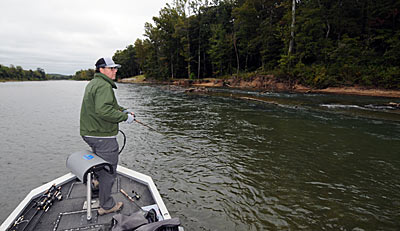
A spring-fed stream such as the Current River remains ultra-clear throughout the fall, so long and accurate casts are required to prevent spooking smallmouth. During our trip, the gigging season for suckers had started, which Smith claims also makes the smallmouth skittish.
The passage of fall cold fronts can also put a damper on smallmouth fishing in rivers but not always. “Any time you have a front come through, the fish shut down on the back side of that front as a general rule,” Smith says. “I have seen times in the fall when a front has come through where the bass have staged up, and maybe that day after the front or three days after, you can still catch fish even though the barometer is high and there are blue skies.”
The smallmouth were along the current breaks in the fast water the first day Smith, fellow writer Zach Smith and I fished the river. Early in the morning, I caught most of my fish on a River2Sea Whopper Plopper 90 that I ran at a steady, medium pace. Later in the day, I switched to a 1/4-ounce spinnerbait for throwing along the logs at the tail end of the swift water and caught several smallmouth in the 12- to 14-inch range. When we drifted into eddies near the fast water, I caught brown bass on a watermelon-red flaked Yum Dinger attached to a ¼-ounce Slider jighead. I would let the Dinger bounce along the bottom, occasionally lifting it to prevent the rig from hanging up in the rocks. Our trip on the river produced more than 40 smallmouth, with several around 12 to 13 inches long and a few 14- and 15-inches.
On the last day, the fishing started slowly in the morning, so Smith ran farther up the river, where we again keyed in on the lower half of the swift water spots. The fish were scattered along the gravel flats, where we caught several on spinnerbaits and swimbaits. We also caught smallmouth on the same lures in the holes littered with logs. Smith caught the biggest smallmouth of the day, about a 2 1/2-pounder, on a black Whopper Plopper that he chugged over the top of a submerged log.
Summarizing our day and a half of fishing on the river, Smith’s prediction was correct: the smallmouth would be at the tail end of swift water spots.
BassResource may receive a portion of revenues if you make a purchase using a link above.


